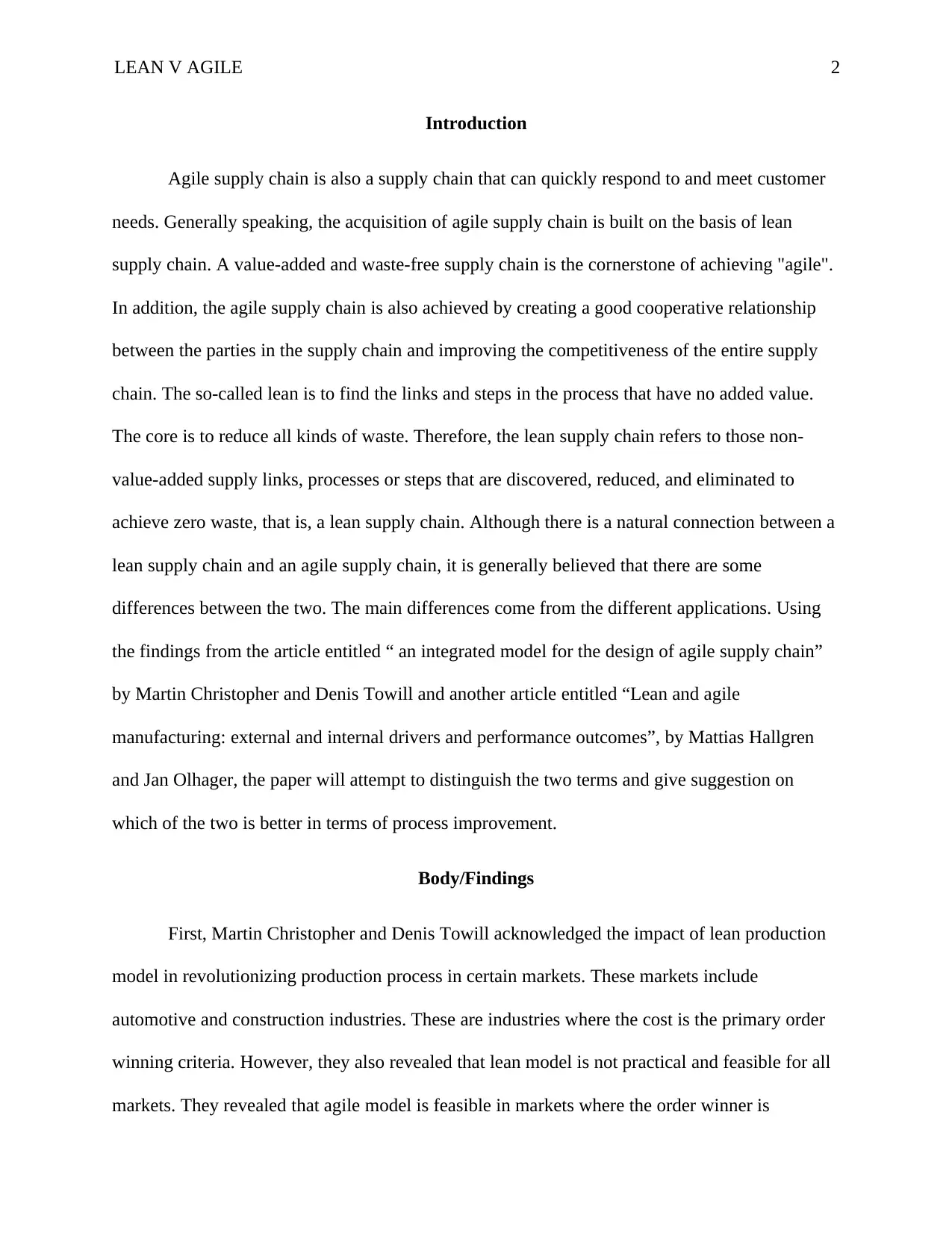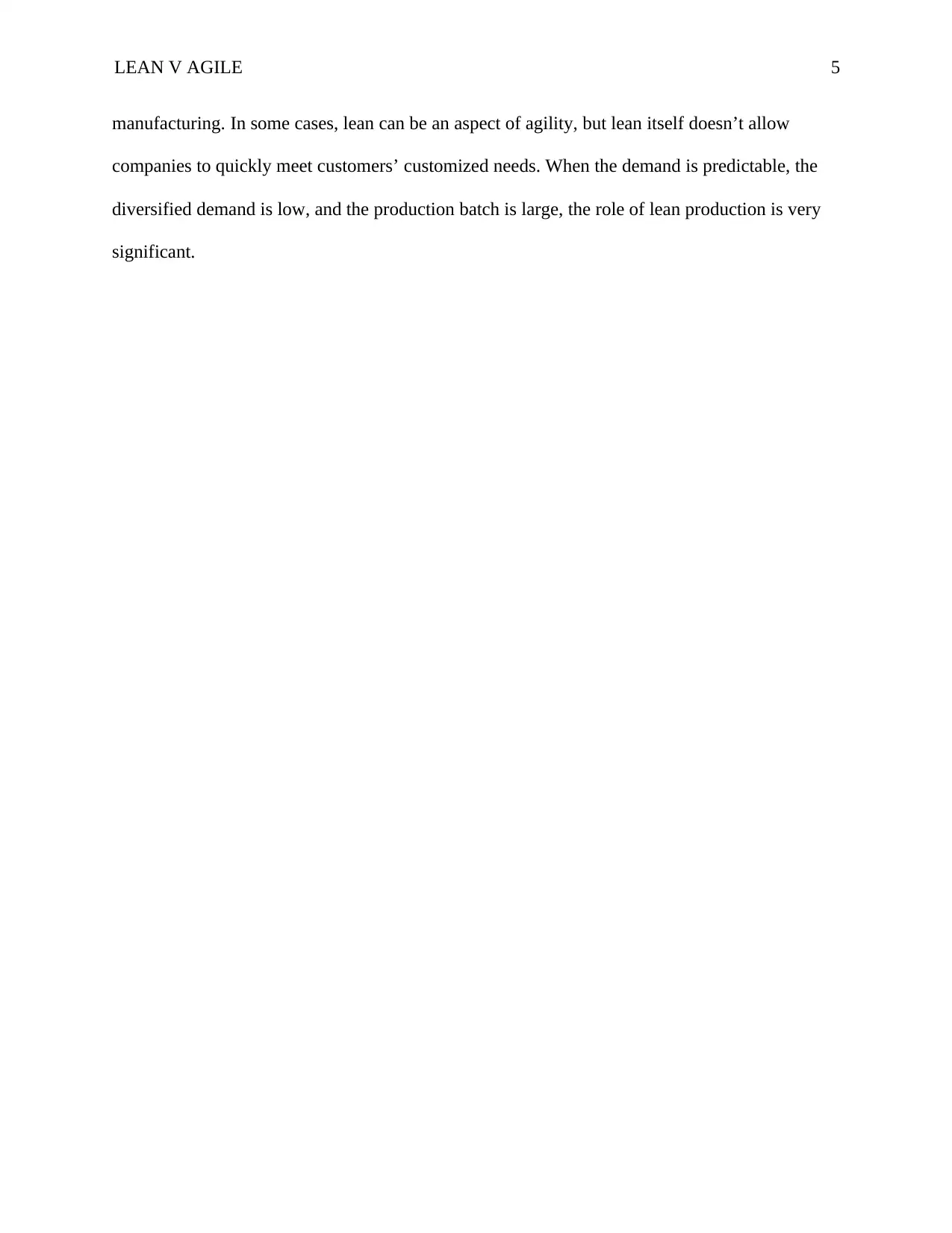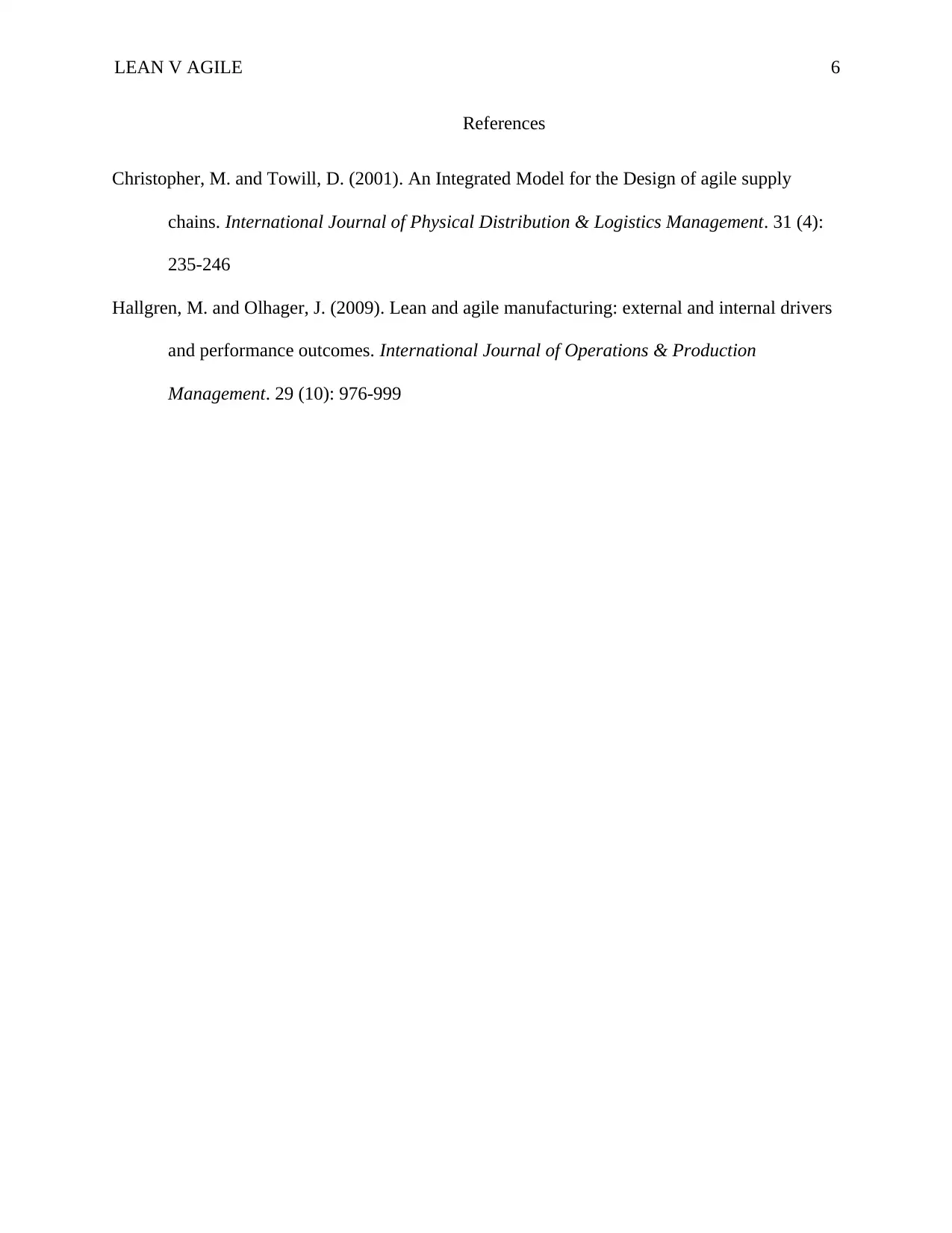Lean vs Agile: An Analysis of Process Improvement Strategies
VerifiedAdded on 2022/09/07
|6
|1201
|40
Essay
AI Summary
This essay explores the contrasting approaches of Lean and Agile methodologies in the context of process improvement and supply chain management, drawing upon the research of Christopher & Towill and Hallgren & Olhager. Lean, focusing on waste reduction and efficiency, is suitable for stable demand environments, while Agile, emphasizing flexibility and responsiveness, is better suited for unpredictable demands. The essay highlights the integration of both approaches, proposing strategies like the Pareto curve and decoupling point to leverage the strengths of each. It also emphasizes the importance of considering internal and external factors, such as cost leadership and differentiation strategies, when choosing between the two models. Ultimately, the essay argues for the adoption of integrated Lean and Agile principles to meet the challenges of an increasingly dynamic market, where time-based competition and the ability to quickly respond to customer needs are critical for success. The essay concludes that the new supply chain integrating Lean and Agile theory will gradually succeed.

Running head: LEAN VS AGILE
Process Improvement, Lean vs Agile
Student’s Name
Institution
Date
Process Improvement, Lean vs Agile
Student’s Name
Institution
Date
Paraphrase This Document
Need a fresh take? Get an instant paraphrase of this document with our AI Paraphraser

LEAN V AGILE 2
Introduction
Agile supply chain is also a supply chain that can quickly respond to and meet customer
needs. Generally speaking, the acquisition of agile supply chain is built on the basis of lean
supply chain. A value-added and waste-free supply chain is the cornerstone of achieving "agile".
In addition, the agile supply chain is also achieved by creating a good cooperative relationship
between the parties in the supply chain and improving the competitiveness of the entire supply
chain. The so-called lean is to find the links and steps in the process that have no added value.
The core is to reduce all kinds of waste. Therefore, the lean supply chain refers to those non-
value-added supply links, processes or steps that are discovered, reduced, and eliminated to
achieve zero waste, that is, a lean supply chain. Although there is a natural connection between a
lean supply chain and an agile supply chain, it is generally believed that there are some
differences between the two. The main differences come from the different applications. Using
the findings from the article entitled “ an integrated model for the design of agile supply chain”
by Martin Christopher and Denis Towill and another article entitled “Lean and agile
manufacturing: external and internal drivers and performance outcomes”, by Mattias Hallgren
and Jan Olhager, the paper will attempt to distinguish the two terms and give suggestion on
which of the two is better in terms of process improvement.
Body/Findings
First, Martin Christopher and Denis Towill acknowledged the impact of lean production
model in revolutionizing production process in certain markets. These markets include
automotive and construction industries. These are industries where the cost is the primary order
winning criteria. However, they also revealed that lean model is not practical and feasible for all
markets. They revealed that agile model is feasible in markets where the order winner is
Introduction
Agile supply chain is also a supply chain that can quickly respond to and meet customer
needs. Generally speaking, the acquisition of agile supply chain is built on the basis of lean
supply chain. A value-added and waste-free supply chain is the cornerstone of achieving "agile".
In addition, the agile supply chain is also achieved by creating a good cooperative relationship
between the parties in the supply chain and improving the competitiveness of the entire supply
chain. The so-called lean is to find the links and steps in the process that have no added value.
The core is to reduce all kinds of waste. Therefore, the lean supply chain refers to those non-
value-added supply links, processes or steps that are discovered, reduced, and eliminated to
achieve zero waste, that is, a lean supply chain. Although there is a natural connection between a
lean supply chain and an agile supply chain, it is generally believed that there are some
differences between the two. The main differences come from the different applications. Using
the findings from the article entitled “ an integrated model for the design of agile supply chain”
by Martin Christopher and Denis Towill and another article entitled “Lean and agile
manufacturing: external and internal drivers and performance outcomes”, by Mattias Hallgren
and Jan Olhager, the paper will attempt to distinguish the two terms and give suggestion on
which of the two is better in terms of process improvement.
Body/Findings
First, Martin Christopher and Denis Towill acknowledged the impact of lean production
model in revolutionizing production process in certain markets. These markets include
automotive and construction industries. These are industries where the cost is the primary order
winning criteria. However, they also revealed that lean model is not practical and feasible for all
markets. They revealed that agile model is feasible in markets where the order winner is

LEAN V AGILE 3
availability. Although Martin Christopher and Denis Towill discussed each of these models
separately, they maintained that the two are not mutually exclusive. In fact, their take away
message is that the companies should attempt to integrate the two.
Christopher and Towill (2001) identified three approaches for integrating the two models.
The first is pareto curve approach. This is based on the fact that in the production process,
products that account for 20% of total output are predictable. Therefore, lean production can be
used for the production of such products, while the remaining products with unpredictable
demand use more agile production methods. The second is the decoupling point approach.
According to this approach, it is believed that for the industry, the supply chain is divided into
two stages, the front stage and the back stage. The front stage of the supply chain uses the
principle of lean production, which mainly produces general modules for products, and the back
stage uses the principle of agile manufacturing, which mainly produces and assembles
customized product parts (Christopher and Towill 2001). The third strategy is separation of base
and surge demands.
Similarly, Hallgren and Olhager (2009) acknowledge lean and agile as two great models
used by managers to improve operations capabilities. However, they also noted that the choice of
which model to adopt depends on internal and external factors. Based on their study, they found
out that the two models differ in terms of drivers and outcomes (Hallgren and Olhager 2009).
They also found out that companies pursuing cost-leadership strategy should consider the lean
model while those companies pursuing differentiation strategy as well as the competitive
intensity of industry should consider the agile model. In terms of outcomes, lean model helps the
company reduce the cost. On the other hand, the agile model helps the company realize higher
volume as well as product mix flexibility. It can be deduced that Lean supply chains are suitable
availability. Although Martin Christopher and Denis Towill discussed each of these models
separately, they maintained that the two are not mutually exclusive. In fact, their take away
message is that the companies should attempt to integrate the two.
Christopher and Towill (2001) identified three approaches for integrating the two models.
The first is pareto curve approach. This is based on the fact that in the production process,
products that account for 20% of total output are predictable. Therefore, lean production can be
used for the production of such products, while the remaining products with unpredictable
demand use more agile production methods. The second is the decoupling point approach.
According to this approach, it is believed that for the industry, the supply chain is divided into
two stages, the front stage and the back stage. The front stage of the supply chain uses the
principle of lean production, which mainly produces general modules for products, and the back
stage uses the principle of agile manufacturing, which mainly produces and assembles
customized product parts (Christopher and Towill 2001). The third strategy is separation of base
and surge demands.
Similarly, Hallgren and Olhager (2009) acknowledge lean and agile as two great models
used by managers to improve operations capabilities. However, they also noted that the choice of
which model to adopt depends on internal and external factors. Based on their study, they found
out that the two models differ in terms of drivers and outcomes (Hallgren and Olhager 2009).
They also found out that companies pursuing cost-leadership strategy should consider the lean
model while those companies pursuing differentiation strategy as well as the competitive
intensity of industry should consider the agile model. In terms of outcomes, lean model helps the
company reduce the cost. On the other hand, the agile model helps the company realize higher
volume as well as product mix flexibility. It can be deduced that Lean supply chains are suitable
⊘ This is a preview!⊘
Do you want full access?
Subscribe today to unlock all pages.

Trusted by 1+ million students worldwide

LEAN V AGILE 4
for situations where demand is stable. Under the premise of stable demand, the process of
satisfying the demand is relatively controllable, so it is more conducive and meaningful to lean
the related process. Agile supply chain is more suitable for occasions with unstable demand. In a
situation with unpredictable demand, if the process of meeting demand is made more flexible,
this requires the sincere cooperation, mutual trust and assistance, information sharing,
coordinated forecasting, parallel planning, and timely replenishment of all parties in the supply
chain. Such as Dell's e-commerce system. It is important to note that from the perspective of
upstream raw material procurement strategies. The agile supply chain attaches more importance
to the control of the entire chain's production capacity, and requires the ability to quickly adjust
the allocation of capacity according to the market.
Conclusion
As the market competition intensifies, the traditional single-company-based business
model will gradually be replaced by an integrated supply chain model. At present, market
demand is full of changes and uncertain factors. Therefore, the agile and fast-response supply
chain for this unpredictable demand will be further developed. The new supply chain integrating
Lean and Agile theory will gradually succeed. The changing market environment and the
uncertainty of the supply chain promote companies to seek new ways of competition, and to
respond to unexpected conditions and the uncertainty of the supply chain in a timely manner. As
a powerful weapon of competition, time has always been the focus of enterprises. Meeting
customer demand in the shortest time possible and ensuring suppliers can meet changing needs at
any time is critical in today’s time-based competition environment. This calls for the need for
agile supply chain. Although the concept of lean production has a profound impact on industry-
wide production practices, the lean thinking model seems to only stay at the level of
for situations where demand is stable. Under the premise of stable demand, the process of
satisfying the demand is relatively controllable, so it is more conducive and meaningful to lean
the related process. Agile supply chain is more suitable for occasions with unstable demand. In a
situation with unpredictable demand, if the process of meeting demand is made more flexible,
this requires the sincere cooperation, mutual trust and assistance, information sharing,
coordinated forecasting, parallel planning, and timely replenishment of all parties in the supply
chain. Such as Dell's e-commerce system. It is important to note that from the perspective of
upstream raw material procurement strategies. The agile supply chain attaches more importance
to the control of the entire chain's production capacity, and requires the ability to quickly adjust
the allocation of capacity according to the market.
Conclusion
As the market competition intensifies, the traditional single-company-based business
model will gradually be replaced by an integrated supply chain model. At present, market
demand is full of changes and uncertain factors. Therefore, the agile and fast-response supply
chain for this unpredictable demand will be further developed. The new supply chain integrating
Lean and Agile theory will gradually succeed. The changing market environment and the
uncertainty of the supply chain promote companies to seek new ways of competition, and to
respond to unexpected conditions and the uncertainty of the supply chain in a timely manner. As
a powerful weapon of competition, time has always been the focus of enterprises. Meeting
customer demand in the shortest time possible and ensuring suppliers can meet changing needs at
any time is critical in today’s time-based competition environment. This calls for the need for
agile supply chain. Although the concept of lean production has a profound impact on industry-
wide production practices, the lean thinking model seems to only stay at the level of
Paraphrase This Document
Need a fresh take? Get an instant paraphrase of this document with our AI Paraphraser

LEAN V AGILE 5
manufacturing. In some cases, lean can be an aspect of agility, but lean itself doesn’t allow
companies to quickly meet customers’ customized needs. When the demand is predictable, the
diversified demand is low, and the production batch is large, the role of lean production is very
significant.
manufacturing. In some cases, lean can be an aspect of agility, but lean itself doesn’t allow
companies to quickly meet customers’ customized needs. When the demand is predictable, the
diversified demand is low, and the production batch is large, the role of lean production is very
significant.

LEAN V AGILE 6
References
Christopher, M. and Towill, D. (2001). An Integrated Model for the Design of agile supply
chains. International Journal of Physical Distribution & Logistics Management. 31 (4):
235-246
Hallgren, M. and Olhager, J. (2009). Lean and agile manufacturing: external and internal drivers
and performance outcomes. International Journal of Operations & Production
Management. 29 (10): 976-999
References
Christopher, M. and Towill, D. (2001). An Integrated Model for the Design of agile supply
chains. International Journal of Physical Distribution & Logistics Management. 31 (4):
235-246
Hallgren, M. and Olhager, J. (2009). Lean and agile manufacturing: external and internal drivers
and performance outcomes. International Journal of Operations & Production
Management. 29 (10): 976-999
⊘ This is a preview!⊘
Do you want full access?
Subscribe today to unlock all pages.

Trusted by 1+ million students worldwide
1 out of 6
Your All-in-One AI-Powered Toolkit for Academic Success.
+13062052269
info@desklib.com
Available 24*7 on WhatsApp / Email
![[object Object]](/_next/static/media/star-bottom.7253800d.svg)
Unlock your academic potential
Copyright © 2020–2025 A2Z Services. All Rights Reserved. Developed and managed by ZUCOL.